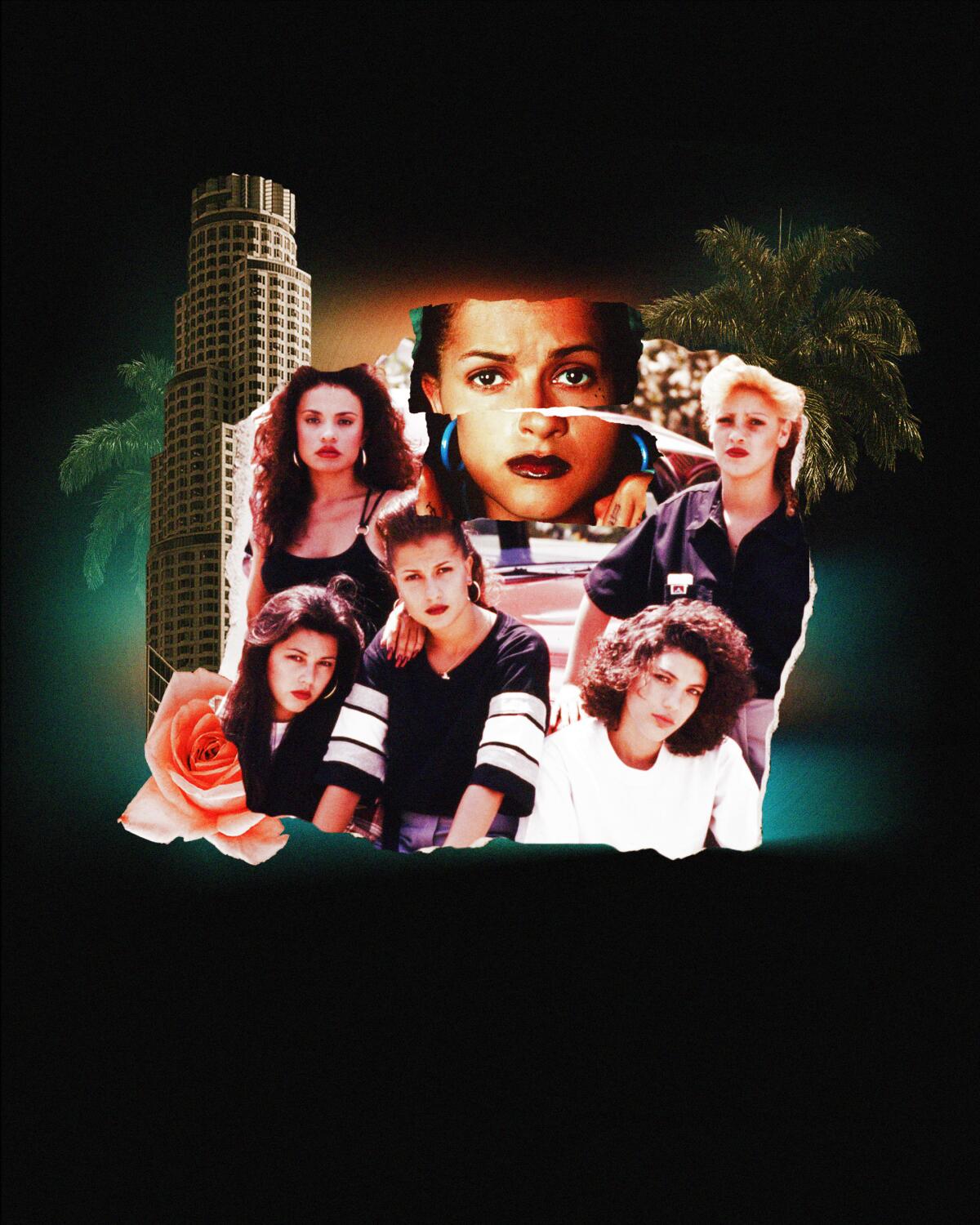Latinx Files: Watching ‘Mi Vida Loca’ on the big screen

On Monday night, at the recommendation of my colleague Mark Olsen’s weekly Indie Focus newsletter (if you’re not signed up, you can do so here), I headed to the Academy Museum of Motion Pictures for a 35mm screening of “Mi Vida Loca.”
Directed by Allison Anders, the film follows Mousie (Seidy Lopez) and Sad Girl (Angel Aviles), members of the Echo Park Locas gang whose longtime friendship is put to the test after both become pregnant by the same man. It premiered at the 1993 Cannes Film Festival and received mostly positive reviews from critics, who hailed it for its authentic portrayal of L.A. chola life — at a Q&A that preceded the recent screening, Anders said she employed and consulted with actual gang members during the entire production process, attributing the film’s authenticity to their involvement.
You’re reading Latinx Files
Fidel Martinez delves into the latest stories that capture the multitudes within the American Latinx community.
You may occasionally receive promotional content from the Los Angeles Times.
“Mi Vida Loca” went on to have a theatrical run before making its way to premium cable and home video, which is where it found its audience (I first saw it on VHS in the mid-‘90s). Much like “Blood In Blood Out,” the Taylor Hackford-directed Chicanx classic released that same year, the film has developed a cult following through word of mouth. Despite not being available on streaming, it has found a new generation of fans thanks in large part to illegal YouTube uploads — in an informal poll, several De Los staff members said they’ve only seen the movie on the video sharing platform.
Monday’s sold-out showing was a rare opportunity to watch it on the big screen.
“There is a strong desire and love for this film. It should be accessible because it’s a time capsule,” said Sari Navarro, film programs coordinator at the museum.
She’s right. In addition to focusing primarily on female characters, “Mi Vida Loca” stands out because it captures a slice of Los Angeles that no longer exists. In the three decades since its release, Echo Park has become increasingly gentrified. In that sense, the film serves as a historical document that chronicles a time when the neighborhood was predominantly Latinx.
Navarro programmed “Mi Vida Loca” as part of “Hasta La Raíz / K’a Pa Ruxe’el /Até A Raiz / Nan Rasin Lan: To the Root,” a film series playing at the Academy Museum until Oct. 13, which she says is her attempt “to showcase different perspectives around the subject of coming of age and what that looks like for Latino young adults in the United States and in Latin America, especially from voices that are marginalized and often overlooked.”
Upcoming screenings include Friday’s showing of “Ixcanul” (2015), which highlights Mayan culture in Guatemala and is filmed in the Kaqchikel language, and “Mi Amigo Ángel,” a 1964 short film from Honduras; “Mosquita y Mari,” the 2012 Sundance favorite directed by Aurora Guerrero (screening Sept. 27); and “Freda,” a coming of age film by Haitian director Gessica Généus that premiered at Cannes in 2021 (screening Oct. 13).
Navarro says this series “really aligns as well with the Academy Museum’s mission of celebrating global cinema and its history through inclusive programs.” Past series celebrating Latin America cinema include 2022’s “Mexico Maleficarum: Resurrecting 20th Century Mexican Horror Cinema” and “Damas de la Pantalla: The Women of Mexico’s Época de Oro,” which screened this summer.
Assembling this most recent series was no easy task. Navarro says she spent a lot of time tracking down copies of the films — “Mi Amigo Ángel” and “Freda” have never been exhibited in the U.S. Even screening “Mi Vida Loca,” arguably the best known title in the program, was only possible because Anders lent the museum her personal print.
All the hard work was worth it, she added.
“At the end of the day, I just want people from the Latino community to feel seen and heard through this series.”
Navarro certainly accomplished that on Monday. As the film played, the close to 300 people sitting at the museum’s Tedd Mann Theater laughed, cheered and applauded. After the screening, a small crowd lingered in the lobby, not quite ready to head home. Some even approached actor Jesse Borrego (he portrayed El Duran) for selfies, which he happily obliged.
I felt mixed emotions on the drive home that night. It was certainly wonderful to have the opportunity to watch “Mi Vida Loca” on the big screen with a captive and enthusiastic audience — the robust selection of repertoire film screenings found in Los Angeles is one of the many reasons why I love living here.
But the screening was also a sad reminder of how invisible we still are to an industry that heavily depends on our dollars — Latinxs account for 24% of box office sales in the U.S., and 24% of all streaming service subscribers. There’s no good reason why films like “Mi Vida Loca” and “Born in East L.A.” aren’t available online, especially when there’s a loyal and willing audience ready to watch them. Just ask Disney. In May, the entertainment behemoth released “Blood In Blood Out” on Hulu and Disney+. Within the days, the film cracked the streamers’ weekly top 10 most watched list.
I’m no studio executive, but I suspect leaving money on the table is the opposite of what these companies should be doing.
Consider subscribing to the Los Angeles Times
Your support helps us deliver the news that matters most. Become a subscriber.

Stories we read this week
Latin Grammys 2024: Édgar Barrera, Bad Bunny and Karol G top this year’s nominations
Global superstars Bad Bunny from Puerto Rico and Karol G from Colombia are at the top of this year’s Latin Grammy nominations, each competing for eight trophies. But it’s the prolific songwriter-producer Édgar Barrera from Texas who emerges for a second year in a row as the leading contender, this time in nine categories — in 2023 he dominated with 13 nominations and took home three golden gramophones.
The author of ‘Tías and Primas’ wants America to rethink Latina clichés. Goodbye, ‘spicy’
Prisca Dorcas Mojica Rodríguez, the author of “Tías and Primas: On Knowing and Loving the Women Who Raise Us,” confronts Latina tropes by highlighting familial narratives.
Pepe Aguilar on life’s cosmic lessons and the new sound he’s rocking
In a career often rooted in reinvention, the Grammy-winning Pepe Aguilar talks about challenging life lessons, career moves and the project he owed himself.
The Latino social media dance enthusiasts inspiring bailes for a new generation
Dance clubs, studios and other venues across the U.S. are partnering with social media Latino influencers to reel in a new generation of música Mexicana dancers.
The Latinx experience chronicled
Get the Latinx Files newsletter for stories that capture the multitudes within our communities.
You may occasionally receive promotional content from the Los Angeles Times.




